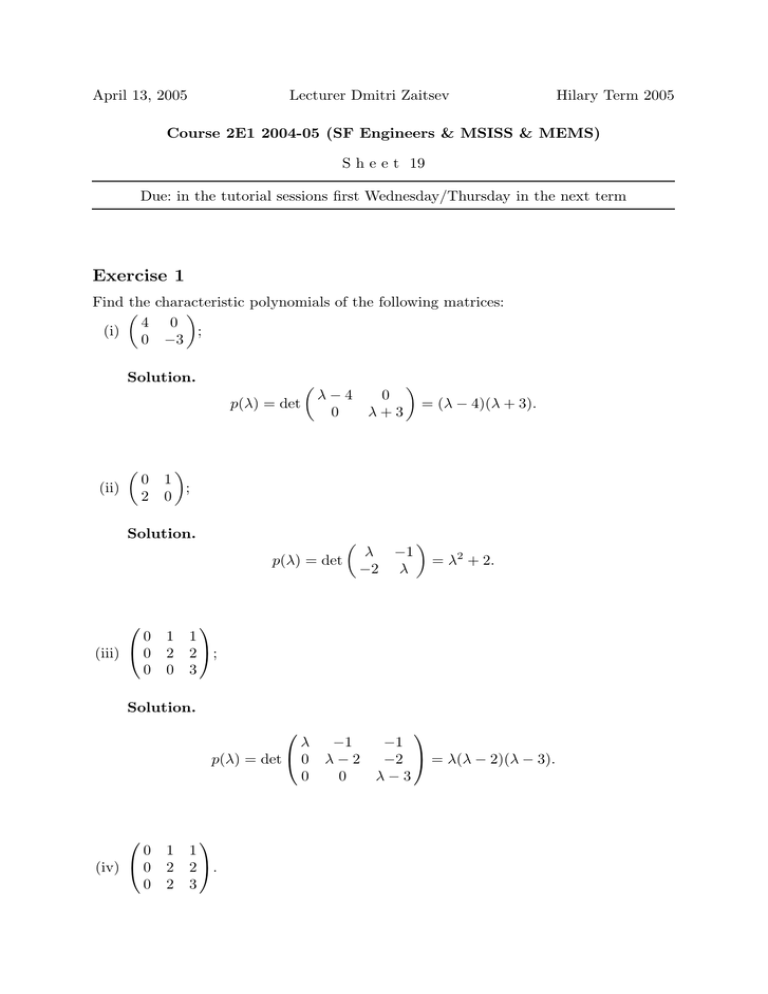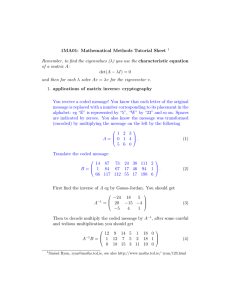April 13, 2005 Lecturer Dmitri Zaitsev Hilary Term 2005
advertisement

April 13, 2005 Lecturer Dmitri Zaitsev Hilary Term 2005 Course 2E1 2004-05 (SF Engineers & MSISS & MEMS) S h e e t 19 Due: in the tutorial sessions first Wednesday/Thursday in the next term Exercise 1 Find the characteristic polynomials of the following matrices: 4 0 ; (i) 0 −3 Solution. p(λ) = det (ii) λ−4 0 0 λ+3 = (λ − 4)(λ + 3). 0 1 ; 2 0 Solution. p(λ) = det λ −2 −1 λ = λ2 + 2. 0 1 1 (iii) 0 2 2 ; 0 0 3 Solution. λ −1 p(λ) = det 0 λ − 2 0 0 0 1 1 (iv) 0 2 2 . 0 2 3 −1 −2 = λ(λ − 2)(λ − 3). λ−3 Solution. −1 −1 λ−2 −2 = λ[(λ − 2)(λ − 3) − (−2)2 ]. −2 λ−3 λ p(λ) = det 0 0 Exercise 2 Find the eigenvalues and the corresponding eigenvectors of the following matrices: 2 0 (i) ; 1 −3 Solution. p(λ) = det λ−2 −1 0 λ+3 = (λ − 2)(λ + 3). The eigenvalues are λ1 = 2, λ2 = −3. For λ1 = 2, the eigenvectors are nonzero solutions of 2−2 0 −1 2 + 3 x1 x2 =0 and we can put x2 = 1 and get x1 = 5 from the last equation. So (5, 1) is an eigenvector corresponding to λ1 = 2. Similarly, for λ2 = −3, we have to solve −3 − 2 0 −1 −3 + 3 x1 x2 = 0, where we find e.g. (0, 1) as an eigenvector. 1 1 2 (ii) 0 2 4 ; 0 2 4 Solution. λ−1 −1 p(λ) = det 0 λ−2 0 −2 The eigenvalues are λ1 = 0, λ2 = 1, λ3 = 6. −2 −4 = λ(λ − 1)(λ − 6). λ−4 For the eigenvectors corresponding −1 −1 0 −2 0 −2 to λ1 = 0, we have −2 x1 −4 x2 = 0, −4 x3 where a nonzero solution is (0, −2, 1). The calculation of the eigenvectors corresponding to λ2 = 1 and λ3 = 6 is similar and omitted. Exercise 3 Find a matrix P that diagonalizes the given matrix A and determine D = P −1 AP : 0 2 (i) A = ; 4 0 Solution. λ −2 p(λ) = det = λ2 − 8. −4 λ √ √ The eigenvalues are λ1 = 8 and λ2 = − 8 and as before we can find as eigenvectors √ √ correspondingly v1 = (2, 8) and v2 = (−2, 8). Then P has v1 and v2 as its columns: 2 −2 √ P = √ 8 8 and D is the diagonal matrix having λ1 and λ2 on its diagonal: √ 8 0 √ D= . 0 − 8 2 (ii) A = 0 0 0 −2 3 0 . 0 3 Solution. λ−2 p(λ) = det 0 0 0 2 λ−3 0 = (λ − 2)(λ − 3)2 . 0 λ−3 We have the eigenvalues λ1 = 2 and λ2 = λ3 = 3. For λ1 = 2, we find v1 = (1, 0, 0) as an eigenvector. For λ2 = λ3 = 3, we 1 0 0 have the system 0 2 x1 0 0 x2 = 0, 0 0 x3 for which we have to find 2 linearly independent solution vectors. The system reduces to one equation x1 + 2x3 = 0, where x2 and x3 can be seen as free and x1 = −2x3 . So we have the general solution putting x2 = t, x3 = s and x1 = −2s: x1 −2s 0 −2 x2 = t = t 1 + s 0 x3 s 0 1 and we can take vectors v2 = (0, 1, 0) and v3 = (−2, 0, 1) in front of t and s respectively as linearly independent eigenvectors. Now we obtain P having v1 , v2 , v3 as columns: 1 0 P = 0 1 0 0 −2 0 1 and D having λ1 , λ2 , λ3 on the main diagonal: 2 D= 0 0 0 0 3 0. 0 3 To verify the correctness of calculations, it is recommended to check that P D = AP.

![MA1S12 (Timoney) Tutorial sheet 7b [March 10–14, 2014] Name: Solutions](http://s2.studylib.net/store/data/011008030_1-c04da3e7c2d74dfcf07e513d17d7896f-300x300.png)


![MA1S12 (Timoney) Tutorial sheet 6c [March 3–7, 2014] Name: Solutions](http://s2.studylib.net/store/data/011008028_1-01e18f611e6c6b52331de87deea17ce0-300x300.png)
![MA1S12 (Timoney) Tutorial sheet 6a [March 3–7, 2014] Name: Solutions](http://s2.studylib.net/store/data/011008026_1-1ee01ebaaf4ce249267696543b52636c-300x300.png)
![MA1S12 (Timoney) Tutorial sheet 7a [March 10–14, 2014] Name: Solutions](http://s2.studylib.net/store/data/011008029_1-475fbfc17f7dd8adff0671cf820bd115-300x300.png)



![1S2 (Timoney) Tutorial sheet 17 [April 7–11, 2008] Name: Solutions](http://s2.studylib.net/store/data/011011731_1-2194fdb691ea6821419ac4cb1c8e89d8-300x300.png)
